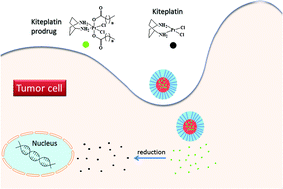Encapsulation of lipophilic kiteplatin Pt(iv) prodrugs in PLGA-PEG micelles†
Abstract
Biodegradable, PEG-coated, nanoparticles (NPs) have gained therapeutic application as injectable colloidal systems for the controlled and site-specific release of drugs. In this paper, encapsulation in PLGA-PEG polymer NPs has been exploited to lower the toxicity and to increase the antitumor activity of kiteplatin ([PtCl2(cis-1,4-DACH)]). Kiteplatin contains an isomeric form of the diamine ligand present in oxaliplatin and proved to be particularly active against ovarian and colon cancers. To favor encapsulation of the platinum drug in the hydrophobic core of the polymeric micelles, Pt(IV) prodrugs having hydrophobic carboxylic ligands at the axial positions were used in place of hydrophilic Pt(II) complexes (compounds 1–4). The size, size distribution, and zeta potential (ZP) were measured by dynamic light scattering (DLS) and laser Doppler velocimetry (LDV), and drug encapsulation efficiency (EE) correlated to the alkyl chain length of the different Pt(IV) prodrugs. The number of the Pt atoms per NP (in the range of 1.3–2.4 × 106) is comparable to that of polysilsesquioxane-based NPs and higher than that found for other nanoparticle platforms. The platinum-loaded PLGA-PEG NPs, tested in vivo in a syngeneic murine solid tumor (LLC), had a higher antitumor effect and, most importantly, were markedly less toxic than kiteplatin.

- This article is part of the themed collection: Metallodrugs: Activation, Targeting, and Delivery

 Please wait while we load your content...
Please wait while we load your content...